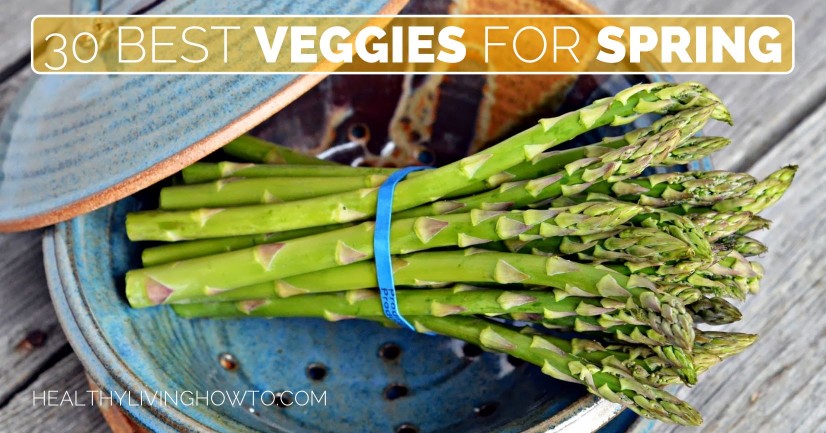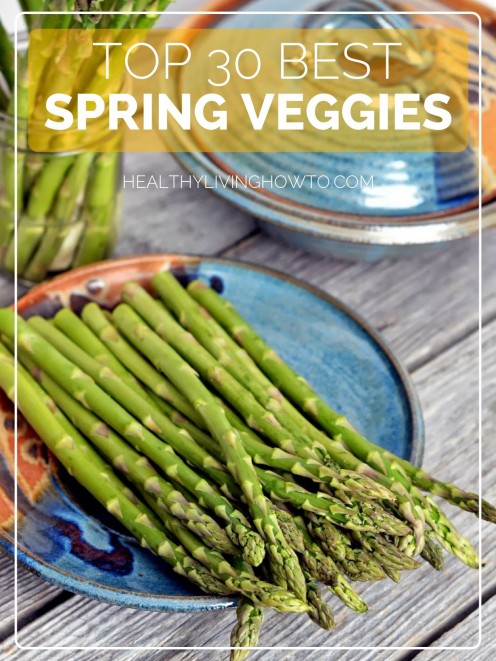We’ve mentioned before how important it is to eat in-season vegetables (preferably local). Since spring’s finally here, we thought we’d share the 30 best vegetables that are naturally ripe in the spring so you can add variety to meals and a sense of fun and adventure to your food shopping and prep.
The 30 Best Veggies For Spring
Asparagus
This is one of the best veggies you can get, and it’s pretty limited. You should be able to find it around February through June, but it will vary based on where you live, of course. It’s great for bloating if you’re feeling a little puffy after too much sodium, and it’s high in fiber, vitamin A, and vitamin K.
Beets
You can get beets year-round, but they’re good to mix in with some of the lighter spring and summer salads. They’re chock-full of antioxidants, calcium, iron, and magnesium.
Broccoli/Broccoli Rabe
Broccoli is another one of those veggies you can buy year-round, but broccoli rabe isn’t available in the hottest months of the year (July and August). Enjoy it in the spring before it disappears for a couple of months. Get calcium, magnesium, zinc, and vitamins A and C for anti-aging benefits and strong bones.
Brussels Sprouts
Brussels sprouts, too, will disappear during the summer months and reappear in the fall. Go ahead and enjoy them in the spring (did you know you can slice them up and make them into the base of a salad?) while you can. They’re full of antioxidants, have anti-inflammatory properties, and even have calcium and omega-3s.
Cabbage
We love cabbage around here, and you can use it for everything from Probiotic & Enzyme Salad to a topping on a green salad to enjoy for lunch or dinner. It’s available year-round, which means it’s the perfect way to continue getting your probiotics and vitamin C regardless of the season. In addition, cabbage offers two other skin-beautifying vitamins, A and E.
Carrots
These are year-round sources of vitamin A (which is good news for your hair). Carrots also contain B vitamins, vitamins C and K, and biotin. They add a little sweetness to any dish, and they’re amazing raw or roasted.
Cauliflower
Available year-round, cauliflower is good roasted, made into mashed “potatoes,” or enjoyed raw. It’s rich in vitamins C and K (so good for your skin), and contains antioxidants and anti-inflammatory benefits.
Corn
Make sure your corn is non-GMO. Corn’s more of a summer vegetable, but depending on where you live, you may be able to enjoy it during the last few days of spring. It’s antioxidant-rich and a good source of fiber, which means it’s good for sweeping waste out of your body.
Chard
Chard is almost available all year, from October to June. Believe it or not, chard’s a source of omega-3 fatty acids. It also contains vitamins C, A, E, and K, plus iron.
Collards
Collards are almost always available, too, but of course that will depend on where you’re buying your produce. Enjoy these used as wraps or even in salads. They’re full of magnesium, vitamins C and E, and they’re great for reducing dark circles under the eyes.
Cucumbers
Cucumbers are a deliciously hydrating staple that are especially good during the warmer months. These may not show up where you are until very late spring, so if you don’t see them as soon as the temperature creeps its way up to shorts weather, be patient. Besides the obvious hydration benefits and refreshing flavor, cucumbers offer vitamin C, B vitamins, and electrolytes. They’re one secret behind beautiful skin.
Green Beans
Locally grown green beans may start showing up where you shop as early as April. Sometimes these are overlooked in favor of more exotic vegetables, but they’re a good source of B vitamins, vitamin K, and manganese. Studies have found them high in antioxidants like lutein, neoxanthin, violaxanthin, and beta carotene.
Green Onions
Green onions are perfect for adding a little intensity to the flavor of a dish. They’re available all year, so enjoy them with all types of vegetables. They contain vitamin A and lutein, so they’re good for your eyes, and they also contain vitamins C and K to keep your body and skin beautiful.
Green Peas
Green peas are generally available in early-to-mid spring. They’re a good source of folate, which makes them a good choice for women of child-bearing age, plus they contain vitamins A, K, and C.
![Top 30 Best Spring Veggies | healthylivinghowto.com Top 30 Best Spring Veggies | healthylivinghowto.com]() Kale
Kale
You know how we love kale! It’s available all year, and great for salads when you just want a hearty green you can mash an avocado (also available in the spring!) into, sprinkle on some other salad dressing ingredients, like nutritional yeast and lemon juice, and have a quick meal. Kale is so full of amino acids, it can help make you stronger, plus it’s full of antioxidants.
Kohlrabi
You may have already been eating kohlrabi since it’s available in the fall, winter, and into spring. You can eat the leaves and the bulbs, and they’re good raw or cooked. It’s high in fiber, so it helps remove waste from your body, plus it’s rich in vitamins C, A, and B.
Leeks
Just like kohlrabi, leeks come into season in the fall and are available through the spring. In some areas, you may be able to get them all year. Leeks are from the same family as garlic and onions and provide a lot of the same benefits. You also get folate and vitamins B6, C, and K.
Lettuce
What would spring and summer be without lettuce? You should be able to find arugula and romaine, but take a look at your local farmers’ market to see what else is available. As long as you’re avoiding iceberg (it’s not at all nutrient-dense), you’ll be consuming lots of antioxidants, vitamins, and minerals with each salad or GGS.
Mushrooms
You can get mushrooms—and their vitamin D content—all year long. While you’ll be getting more vitamin D from the sun in the spring, you should still include them in your diet if you love them. They’re a good staple to toss into a stir-fry or salad. You can even keep them around as snacks and much on them when you’re starving and dinner’s an hour away.
Mustard Greens
Mustard greens are another leafy green that’s available all year. Like collards, these may not be the tastiest option to load into your GGS, but they’re still worth keeping as part of your diet for variety’s sake. They’re rich in vitamins K, C, and A, which means they’re good for blood detoxifying as well as beautiful skin and hair.
Okra
Okra won’t generally make its way to the market until late spring. If you’re looking for a veggie that will boost your folate and other vitamin B levels, plus give you the benefits of vitamins A and C as well as iron, magnesium, calcium, and manganese, don’t pass okra by.
Onions
The antibacterial properties of onions make them a must-have all year. Like garlic, onions contain an antioxidant called quercetin, which can help with springtime allergies. It doesn’t hurt that they can take the flavor of your food up a notch.
Parsnips
In early and mid-spring, you should still be able to enjoy local parsnips. These are good sources of folate, fiber, potassium, and vitamin C.
Radishes
These don’t get nearly enough attention, but they’re available year-round and can give your meal an unexpectedly spicy kick. They also have vitamin C and sulfur. They’re good for your hair and your digestive tract.
Rutabagas
In early and mid-spring, you should still be able to enjoy local parsnips. These are good sources of folate, fiber, potassium, and vitamin C.
Spinach
Spinach is one of the most versatile greens around, and you can get it all year. Toss it into smoothies (you don’t taste it, no matter what the flavor profile of your smoothie is like) or use it as the base of a salad. Spinach is rich in beta-carotene, vitamins C and E, and iron.
Sprouts
Sprouts are some of the most nutritionally dense foods, and you can get them in the spring (or summer, fall, or winter). The amount of antioxidants in sprouts is a little astounding, and it makes them perfect for nourishing your cells.
Squash
What you’ll be able to get in your area may vary quite a bit, plus it will change throughout the spring. We’ll be saying goodbye to the winter varieties of squash and finding summer squash at the market. Depending on the variety you get, you’ll get tons of fiber, antioxidants, vitamins, and minerals. Winter squash varieties are especially high in vitamins A and C.
Tomatoes
Vibrant, red, juicy tomatoes are big in the summer, but it’s possible that you could have them in mid-to-late spring. They’re incredibly antioxidant-rich (especially in lycopene). They’re high in vitamin C and biotin.
Turnips
Yet again, a leafy green you can get all year. Use turnips to help rotate your greens and make sure you aren’t getting too much of any one kind. From these, you’ll get vitamins C, K, A, E, plus calcium, copper, iron, manganese, and fiber.
Not all of the 30 best veggies that are naturally ripe in the spring are exclusive to spring. Some are available all year (or almost all year) while others have their fleeting moments in-season. Snatch those up while you can and enjoy them, and continue using some of the others that are available year-round as trusty go-to items. Remember to always rotate your produce, even the things you can get all year.
Written by Christina Davis and originally published at KimberlySnyder.net. Syndicated with exclusive permission for Healthy Living How To.

